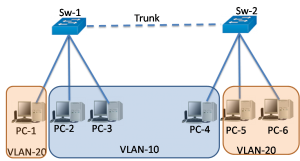Introduction to VLAN Trunk
In telecommunications, the trunk is a link to carry multiple signals simultaneously and providing network access between two points. It provides network access to many clients by sharing a set of lines or frequencies instead of providing them individually.
This is similar to the structure of a tree with one trunk and many branches. Typically, trunks connect switching centres in a communications system. There are two types of trunks using a data network.
- Trunks that carry data from multiple local area networks (LANs); or virtual LANs (VLANs) across a single interconnect between switches or routers, called a trunk port.
- Trunks that combined multiple physical links to create a single higher-capacity, more reliable logical link, called port trunking.
As we mention above that trunk is a point-to-point link between two network devices that carry data for more than one VLAN. A VLAN trunk extends VLANs to a whole network.
Cisco support standard 802.1Q for VLAN tags for Ethernet frames as they pass between switches, so each frame is routed to its planned VLAN at the other end of the trunk. We can use Ethernet, Fast Ethernet, Gigabit Ethernet, and 10-Gigabit Ethernet interfaces as a trunk port.
Without VLAN trunks VLAN is not very useful. Trunks let all VLAN traffic broadcast between different switches so that devices that are in the same VLAN; but connected to different switches, can communicate without a router.
A VLAN trunk does not belong to a particular VLAN; but, it is a medium for several VLANs between switches and routers. We can use a trunk between a network device and server or other devices configured with an appropriate 802.1Q-capable NIC. By default, All Cisco Catalyst switch support the trunk port.
In the figure, the links between both switches are configured to transmit traffic coming from VLANs 10; and 20 across the network. This network could not function without VLAN trunks.


